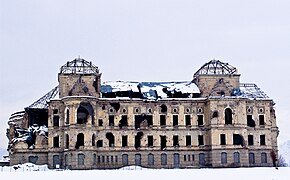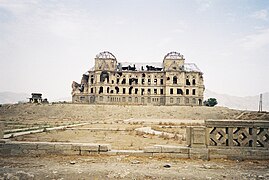Darul Aman Palace
| Darul Aman Palace | |
|---|---|
قصر دارالامان - د دارالامان ماڼۍ | |
 The palace in January 1982, which was heavily damaged in the 1990s and fully restored in recent years | |
 | |
| General information | |
| Status | Reconstructed in 2019 on the 100th Independence Day of Afghanistan |
| Type | Palace |
| Architectural style | Neoclassical |
| Town or city | Kabul |
| Country | Afghanistan |
| Construction started | 1925 |
| Completed | 1927 |
| Renovated | 2016-2019 |
| Renovation cost | $10-20 million[1][2] |
| Height | 107 ft (33 m) |
| Technical details | |
| Material | Brick Marble (spiral staircases) |
| Floor count | 3 |
| Design and construction | |
| Architect(s) | Walter Harten A. Godard M. Godard |
| Other information | |
| Number of rooms | 150 |
Darul Aman Palace (
The 150-room Darul Aman Palace was originally built in the 1920s, during the reign of
History
Construction of the Darul Aman Palace began in the early 1920s as part of the endeavours of

The palace is an imposing
The building was gutted by fire on 14 December 1968, and was afterwards restored to house the
In 2005, a plan was unveiled to refurbish the palace for use as the seat of Afghanistan's future parliament.[14] It was to be funded primarily by private donations from foreigners and wealthy Afghans.[15] In April 2012, a number of government compounds around the palace were targeted for attacks by Taliban-led insurgent groups.[16] Eventually it was decided to develop a new building opposite the palace to house the parliament under a grant, provided by India. Construction was completed in 2015.
In the Spring of 2016, work began on a 16 to 20 million dollar restoration project,[17] intended to renovate the palace in time for the centenary of Afghanistan's full independence in 1919.[18][1][4] Nearly 600 tons of debris was initially removed from the 150-room building and by the spring of 2017, workers were taking down plaster and concrete from the inner walls.[10] Over 80 engineers and architects were involved in the project, of which 25 percent were female. By July 2019, most of the major reconstruction work on the palace was completed.[2]
On 18 April 2020, an opening ceremony was held as the palace was used as a temporary COVID-19 isolation and treatment center with 200 beds during the COVID-19 pandemic in Afghanistan.[19]
Architecture
The palace is a U-shaped brick building, built in a
Gallery: Darul Aman Palace before renovation
-
The palace in 1986
-
2002: The southern facade
-
2002: US commandos patrolling a heavily bombed out room
-
2002: Two US Special Forces soldiers view Kabul looking north
-
2005
-
2006: Northern elevation showing shelling damage inflicted during mujahideen fighting for Kabul after Soviet withdrawal
-
2006: Western elevation
-
2007: After heavy snowfall
-
2008: Facade
-
July 2010: The interior was in very bad shape
-
December 2015: View from the National Assembly Building with the palace under preliminary reconstruction
See also
- Aman (Islam), Islamic term for offering safety, protection, safe conduct, or pardon to enemies
- Tajbeg Palace, located on a nearby hill and built as a residence for Amanullah, his wife, Queen Soraya, and their family.
- Bagh-e Bala Palace, a palace built as a leisure home for Abdur Rahman Khan in 1893
References
- ^ a b "Feature: Afghan former king's reconstructed palace beautifies Kabul landscape". Xinhua. 2019-08-10. Archived from the original on August 16, 2021. Retrieved 2021-01-26.
- ^ a b "Afghan palace emerges from ruins as centenary nears". Arab News. 2019-08-16. Retrieved 2021-01-26.
- ISBN 1-85109-402-4, page 29, 67.
- ^ a b c "Restored national treasure a bright spot for Afghans as they celebrate independence day holiday". Stars and Stripes. August 21, 2020.
- YouTube, Jan. 5, 2019, National Defense and Operations Directorate chaired by JHA
- ^ "Darul Aman Palace opened to the public and tourists". aop.gov.af. 1 November 2023. Retrieved 2016-02-24.
- ^ "Kabul to Darulaman railway". Sndrewgrantham.co.uk. Retrieved 2016-02-24.
- ^ "Cabinet Approves Darul Aman Palace Reconstruction Budget". Sada-E-Azadi. 12 March 2016. Archived from the original on 2018-02-08. Retrieved 2019-03-16.
- ^ Azadi, Sada-e. "Cabinet Approves Darul Aman Palace Reconstruction Budget". www.sada-e-azadi.net. Archived from the original on 2018-02-08. Retrieved 2018-02-07.
- ^ a b c d e "Saving an Afghan Symbol, With Afghans Only". The New York Times. April 5, 2017. Retrieved 2017-04-06.
- ^ "Art Of War - Военно-исторический литературный портал". 2018-07-29. Archived from the original on 2018-07-29. Retrieved 2020-05-16.
- ISBN 91-86936-01-8.
- ^ Ghani, Mariam & Ashraf (8 September 2012). "Palace of Abandoned Dreams".
- ^ "Place to see: Darul Aman Palace, Kabul, Afghanistan". Archived from the original on December 21, 2009. Retrieved February 1, 2010.
- ^ "A million afghanis donated to palace reconstruction". Pajhwok Afghan News. 14 April 2012. Retrieved 2023-11-30.
- ^ "Taliban strike across Afghanistan in 'spring offensive'". BBC News. 16 April 2012.
- ^ "Cabinet Approves Darul Aman Palace Reconstruction Budget". TOLOnews. 10 March 2016. Retrieved 2023-11-30.
- ^ "Afghans Celebrate 100th Independence Day". TOLOnews. 19 August 2019. Retrieved 2023-11-30.
- ^ "COVID-19 Cases Reach 933 in Afghanistan". TOLOnews. 18 April 2020. Retrieved 2020-05-16.
- ^ "In pictures: Kabul's battle-scarred palace". BBC News. 2014-11-09. Retrieved 2020-05-16.
- ISBN 2-940075-09-3.
External links
- دارالامان ماڼۍ ، د نیوکلاسیک معمارۍ سره on YouTube(Nov. 16, 2023)
- آیا باورتان میشود که حالا همه مردم میتوانند از قصر دارالامان از نزدیک دیدار کنند؟؟ on YouTube(Nov. 12, 2023)
- Darul Aman palace is no longer a restricted site /قصر دارالامان دیگر قفل ندارد، گزارشی از حفیظ امیری on YouTube(Ariana News, Nov. 8, 2023)
- Afghan Scene - Visiting Darul Aman Palace in Kabu on YouTube(Sept. 30, 2022)
- Darul-Aman Project for Kabul
- The story of the german ingenieur Wilhelm Rieck. Many historical pictures
- The Shattered Remains of Afghanistan’s Versailles












